Today, we’re going to have an art history lesson on Egyptian art and culture, as it could relate to Magic’s newest expansion, Amonkhet.
What does an Egyptian based set mean for Magic: The Gathering?
What should we look for besides pyramids and sphinxes?
 Before I explain what to look for in the set, we must cover the basics of why we even talk about Egyptian art so often. It’s been used, remixed, parodied and set as gaming background as far back as cultures were being investigated.
Before I explain what to look for in the set, we must cover the basics of why we even talk about Egyptian art so often. It’s been used, remixed, parodied and set as gaming background as far back as cultures were being investigated.
I am not an expert on Egyptian art and I have my own biases in speaking about art, clearly. To write succinctly and respectfully, I enlisted Sonja Boschman or @Rudjedet, for an Egyptologist’s insight into writing. She has been invaluable in her support of getting the Magic player base informed and you will see her thoughts throughout the article today.
To start, what’s the fascination with this culture?
Our Fascination’s Start: Egyptomania
If you have ever wondered why we Americans have a fascination with Egyptian culture, the admiration goes back to Napoleon. It becomes a bit shameful and nefarious after that.
At the turn of the 18th century, France and Napoleon traveled to Egypt and won decisive battles at the Battle of the Pyramids against the Egyptians and the Mamluks.
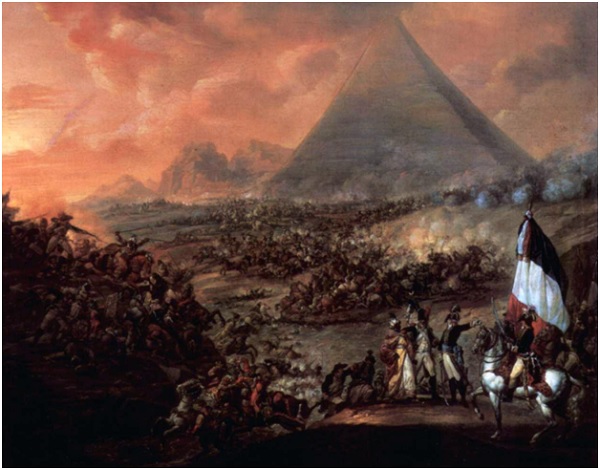
The Battle of the Pyramids, François-Louis-Joseph Watteau, 1798-1799.
With a major international military and cultural power of France bringing back knowledge of Egyptian culture, for a full century France was enamored by their role in the conquest of Egypt. When the French re-found the Rosetta Stone a few years later, it shaped the entire course of history’s understanding of Egypt.
Prior to the Rosetta Stone, historians had a decent understanding of roughly what Hieroglyphics represented. Those parts were clear-the afterlife and a divine representation, amongst others. For over 1500 years, historians still had a living culture to understand much of hieroglyphics but just as American English in 1800 vs. 2017 is quite different in both script, slang and trends, historians were missing a ton of words to fill in holes in translating. Then, the stone was found.
The stone had three language translations on it, linking scholarship rather quickly. Scholars visited Egypt in the early Renaissance, Rome wasn’t that far away and Egypt was part of the Roman Empire.
It took over twenty years to get close to a full grasp of the Hieroglyphics from Demotic to Ancient Greek, and building citations and bibliographies of scholarly findings. Greek was already understood, allowing current languages to fully decipher Egyptian documents, art and culture. Imagine learning German without gendering words — you can kind of understand it but some words make no sense and you have to guess.
Napoleon’s expedition and the extraction of the Rosetta Stone gave rise to Egyptomania.
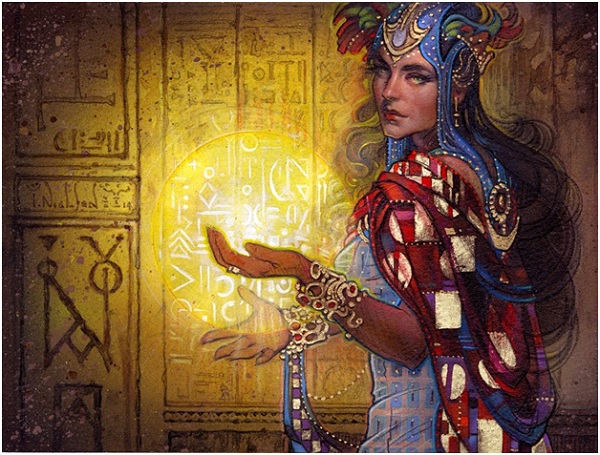
Mother of Runes by Terese Nielsen
To say it was a craze of learning about Egypt is an understatement. It was Egyptomania. The results were far from positive either.
Even fledgling America became crazed with Egypt. America was interested in it for different reasons. By erroneously showing how a major civilization like Egypt had both slaves and some type of racial hierarchy justified through pictograms, the ideals, culture and art spread quickly. Artifacts were purchased during a rapid increase of cultural institutions and museums in the states. Even mummies were purchased for use during “unwrapping parties” that were for the mega wealthy. I knew there was more to this, so I asked Sonja about it:
Dang.
Another of the crazed admiration were obelisks. They were petrified sun rays of course, the tallest being Hapshetsut’s at over 97 feet tall. They went from antiquity item to fascination. Worldwide had architects copy the style and incorporate into contemporary culture. The Washington Monument was created in the mid 19th century, “evoking the timelessness of ancient civilizations.” You’ll see them today in Paris to Rome, and in a variety of European cities to commemorate battles to idealizing freedom.
In Magic, they’re simply artifacts with random usages, notably tapping for mana on Alara.
 |  |
| Unstable Obelisk by William Wu / | Washington Monument |
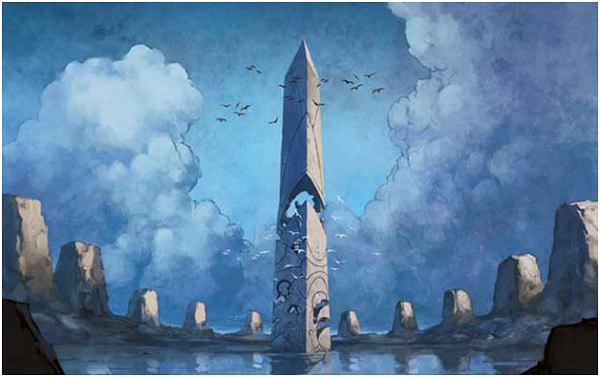
Obelisk of Esper by Francis Tsai
Egyptian Culture - Longevity Means Static?
Comparing Egyptian art and culture that spanned hundreds of to similar veins is difficult to convey. If we look at 20th century art movements like Futurism, Pop Art and the like, our notion of art is seconds compared to entire generations. The rise and fall of families would still have one style of dominant art in ancient Egypt. Cubism was decades ago and look at art now. In Egypt, you change 40 years and yup, the pyramids are still there. Twenty more years pass; they still have pyramids.
Whereas medieval cathedrals took decades to build, often improving structure and style the entire time, Egyptian culture could often be created and enjoyed in a relatively similar culture as when it was built. Things were made to last in Egypt and to talk about their current art or their ancient artforms are impossible to decouple. While the art did change, and calling it static is problematic, their culture was so similar for such a long period of time, no civilization has lasted longer under anything remotely comparable.
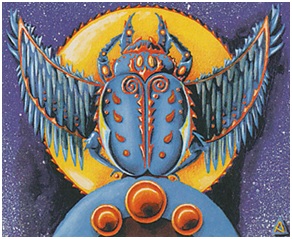 |  |
| Blue Scarab by Amy Weber / | Red Scarab by Kaja Folio |
Wall inscribed hieroglyphics and stone carvings, despite kings changing and improvements in creative process achieved, still kept a solid depiction. They are static images and as such, divinity was carved into rock as never changing, always stable. The medium fit the intention.
Add in religion to codify the art form and since it often related to the afterlife, it was only sparsely subject to change and even then, to an untrained eye it was similar. Wall carvings had instructions for the afterlife — what type of food the king liked or was to be given was shown. In addition, objects were also in tombs like food and pots filled with various items they would use in the afterlife, even tools.

Imagine being the next king, would you really be randomly into watercolors or into static images that guaranteed you barbecue chicken sandwiches in the afterlife? Art followed custom, custom became tradition and traditions are mighty hard to break.
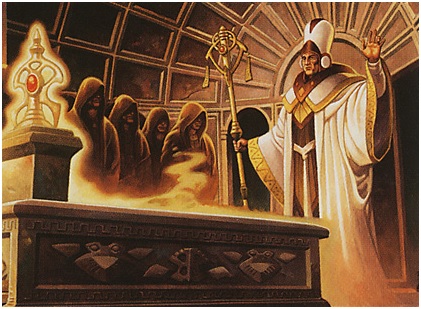
Proper Burial by Luca Zontini
There was one pretty huge change, which Sonja elaborated on when I asked her more about it:
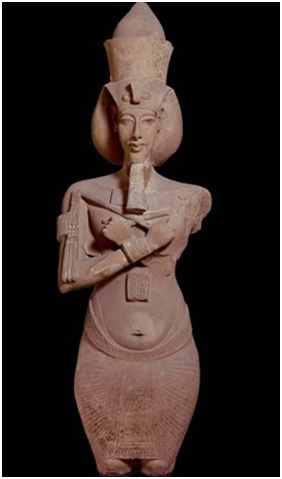 |  |
| Unknown. Akhenaten, 18th Dynasty, ca. 1353-1335 BCE. From the temple of Aton, Karnak, Egypt, Sandstone / | Standing Figure of Nefertiti, ca. 1350 BCE. From Amarna, House P 47.2, Limestone |
First thing to look for - the Nile
Egypt is in a desert. It also has the largest river in the world. Those two points have a feast and famine geography built into their culture.
Amongst the sand, you will find life. The silt deposits carried down the NIle made land fertile because the river overflowed the banks during the flood season. Without the Nile, Egypt couldn’t make wheat to feed its people, cattle or trade. If you’re curious how the Nile comes to be, it’s from melted snow from mountains. It certainly felt like a divine influence back then though, of course.
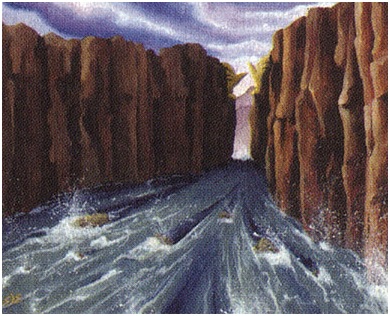
Raging River by Sandra Everingham
The Nile flooded every year, it brought life with it that allowed planting, and then food was harvested. It created a cycle that was reliable and in a climate as inhospitable as the desert, when the rain stopped and the sun went down for the day, life flourished or ceased to exist. The seasons were named Akhet, Peret, and Shemu, each four months of thirty days each in length, making up a solar year after the addition of five festive days to get to 365.
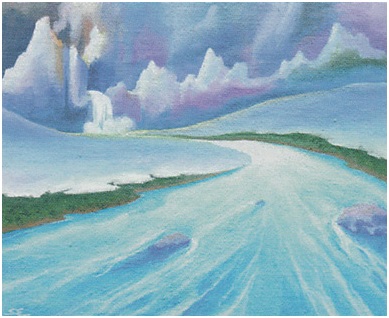
River Delta by Sandra Everingham
Those cycles allowed people to store food, build granaries and think of why this kept occurring. It created the concept of time since something created the sun’s warmth and the life of the Nile.
Second thing to Look For - Dollar Store Egypt
Immediately after searching for the river based images, you should be on the lookout for the stereotypical Egyptian architecture, art and cultural items.
What I fully expect is to see the art of the dead in Amonkhet in full view. If you visit a modern art museum with a large Egyptian area, you’ll learn that most burial Egyptian art was never seen by citizens, at least not the art we see associated with Egypt. Egyptian art was for the dead, to honor them and aid them. What was more commonly seen and used by the living was giant relief sculptures, amulets, jewelry, cosmetic cases containing makeup ink, furniture and pottery. It’s not what we think of as being highly Egyptian but in normal society, high quality linen clothing with extensive makeup is more correct.
Though, Egypt means this to many, which we’re already seeing in Amonkhet because it’s visual shorthand and minimizes confusion:
Pyramids

Pyramids by Amy Weber
We’ve already seen a few of them in the set. We haven’t seen the different types of them yet, like the earlier versions of step pyramids. We only have the finalized form. If you visit Cairo now, you’ll notice the edges aren’t smooth. Earthquakes and reusing the bricks for other local projects have make them a bit less smooth than you’d think.
Sphinxes
Magic has had a resurgence of sphinxes since Alara, containing them in both core sets and incorporating into expansion sets. To not see a sphinx, especially a three color sphinx, would be a serious miss.
Though, you do know that all of Magic’s sphinxes are based on Greek depictions, right?
Egyptian sphinxes don’t have wings.
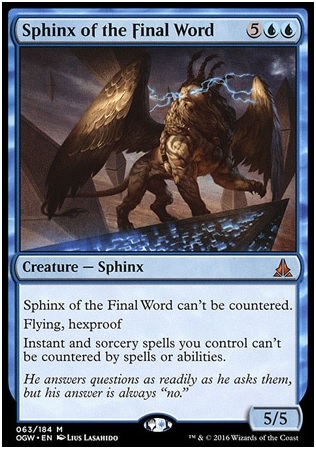
Mummies
The creature type that covers mummies are zombies, which like Dungeons and Dragons, they simply cover as “undead” creatures. I’m convinced that Mournful Zombie counts, though how much closer are mummies to zombies vs. skeletons?
Wizards has already shown Liliana depicted with “zombies” and we can see they are wrapped like mummies.
Keep a close watch on the age of bandages. Considering the time elapsing between mummification and reanimation by a necromancer, keeping it realistic will be tough.
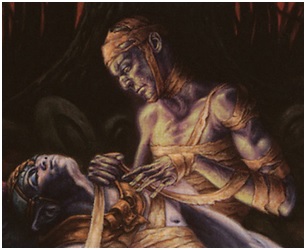 |  |
| Mournful Zombie by John Matson / | Cyclopean Mummy by Edward P. Beard, Jr. |
Ankhs

Ankh of Mishra by Amy Weber
A symbol meaning life, Magic has only one card that is an artifact of this creation. Considering the tie to gaining life in the game as a mechanic, it’s odd how the actual Ankh of Mishra deals damage instead of gaining life. The symbol was appropriated by some sects of Christianity to represent Jesus Christ, or the giver of life, as it were.
How much will a precedent prevent us from new ankhs? We’ll see.
Scarabs
 | 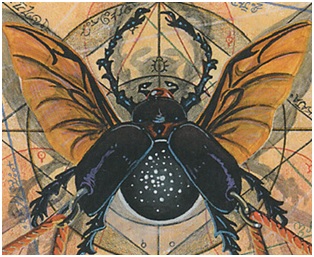 |
| Green Scarab by Nicola Leonard / | Black Scarab by Kaja Foglio |
Scarabs are one of the most powerful symbols of the victory life over death. Sonja explains:
In short, the scarab held importance to the Egyptians because of its association with the sun and the sun's journey through the underworld.
In Magic, scarabs are either Ice Age auras or protection or insect creatures, with Golgari of Ravnica being the stalwart for their creation. In a top-down Egyptian set, having something scarab related that would regenerate a creature would be incredibly flavorful. I would be on the lookout for that.
Hieroglyphics
Much of hieroglyphics, as we see them, are monumental. The Egyptians often carved them into the walls of their temples and tombs. They, like medieval church exterior sculpture, were also generally painted. They were colorful! We won’t see painted hieroglyphics in Magic. Without experts in art history, it would be hard to pitch to higher ups in the company that all the stone covered known cultural items were gaudy and colorful.
Third thing to look for - Egyptian Sculpture
To train your eye to Egyptian art hidden below the surface, do not forget that Egypt is in the desert. The dry climate preserves some art incredibly well. They don’t have as much erosion due to rain, snow and wild temperature changes.
Their art was hidden in tombs and also massive. The ones in tombs are largely lost too. Much of the art and items were stolen (looted) from tombs thousands of years ago. Artifacts and fakes had a market and enterprising businesses took advantage of that nearly immediately.
Some tombs were moved to prevent looting and the massive statues to pieces of the pyramids themselves weren’t necessary looted but rather, appropriated for other usages. It’s a lot cheaper and easier to take a few bricks to build a mosque in medieval Egypt vs. pay a quarry to source and hire masons to carve stones. Luckily, the mediums of the giant statues were mighty hard to reuse and not be noticed since they used a solid piece of stone. Sonja speaks of appropriation of statues and more:
Wait, what’s this about a solid piece of stone?

Egyptian artisans were experts at relief sculpture. A relief is a sculpture that is part of a wall or structure, showing sculpture with an attached background. To make it easy to understand, they can be sunken, high relief or low (bas) relief.
Sunken Relief
 Sunken also called incised relief, in which the carving is sunk below the level of the surrounding surface and is contained within a sharply incised line that frames it while integrating light and shadow. They are not always small or large either! See Thoth at Luxor here.
Sunken also called incised relief, in which the carving is sunk below the level of the surrounding surface and is contained within a sharply incised line that frames it while integrating light and shadow. They are not always small or large either! See Thoth at Luxor here.
High Relief
Relief that is considered “high” means that sculptural elements are fully projected from the back piece of stone, especially limbs and rounded forms like a head. In these sculptures, you can fully see them “jut out” from the wall. These tend to be human sized or considerably larger, despite the added weight being unattached to the back wall of stone. They were rather rare in much of Egypt’s history and became more prominent during Greek influence, like the Parthenon and friezes, like shown below or like we see in the background of Amonkhet already:
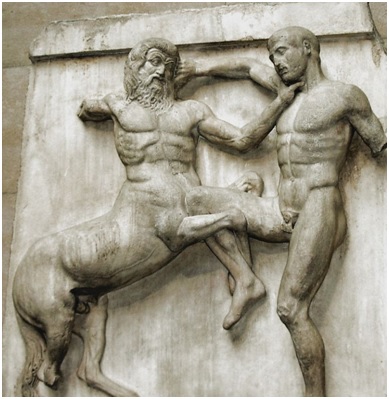
Lapith fighting a centaur. South Metope 31, Parthenon, ca. 447–433 BC. Elgin Marbles, British Museum.

Bas Relief
To show bas or low relief, a sculpture is barely moving out from the base wall. To see it in comparison to high relief, look at the horse’s rear leg above. It’s carved from a piece of stone still, but it’s still fully connected. This type of relief was most commonly used in Egypt.
Much of the Hero - Face the Hydra cards in Born of the Gods, of the Theros block are low relief sculpture. Of which, I think the artist Chuck Lukacs has a few of those paintings he made of the over two dozen left. They’re incredible up close.
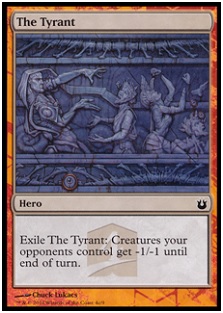 | 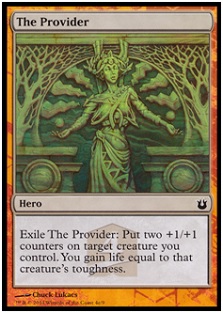 |
Fourth thing to look for - Symbolism
Symbols, icons and finding meaning is calling iconography. It’s a Dan Brown sort of term, I know, but stay with me.
Egypt had its own art rules and symbols, which are incredibly complicated and too lengthy for an article like this. You haven’t the time nor the patience for forty pages on major, minor and tertiary meanings. So we’ll go quick.
Aspective: Egyptian art are flat images, with objects shown at different angles that depicted the most information about the subject. If you show the shoulders in profile, you would lose one side, or feet shown from the front. One can read feet more easily from the side compared to a frontal view. Likewise, if a pot was depicted on a wall, whatever is within it would also be shown either floating above or near it. You didn’t have to wonder, you just knew.
Colors: Gods had bones of silver, eyebrows of lapis, and skin of gold. Yellow tied to both the sun and gold. Lapis lazuli is a richly deep blue stone and antiquity loved using it. They shortened it to call it lapis. If you’ve ever been to Berlin, you’ve seen lapis up close at the Ishtar Gate.

Treasure of Queen Amniskakheto
Merotic period, reign of Queen Amanishakheto, 10 BCE – 1CE
More on color, men were generally red in color and women were yellow. I checked with Sonja to find out why:
Egyptians had a stereotypical method of depicting different peoples and genders. Gods are usually presented with the skin color of their gender — so reddish brown for gods, pale pink/yellow for goddesses — but not always. Osiris, for example, is always portrayed with black or green skin to represent rebirth. When gods are shown with animal heads, the rest of their body matches the skin tone of their gender. In the case of gods with a complete animal form, it depends on the animal which color they use.

Pair statue of Ptahkhenuwy and his wife
Egyptian
Old Kingdom, Dynasty 5
2465–2323 B.C.
Painted limestone
Findspot: Egypt, Giza, tomb G 2004
Harvard University—Boston Museum of Fine Arts Expedition
Size according to status: Pharaohs were shown larger in scale vs. a commoner. Kings and pharaohs were often shown at the same scale as deities. Again, Sonja:
It wasn’t xenophobic or stereotypical, it was just shorthand.
Lotus flowers: The plant was a symbol for fertility and a symbol for Upper Egypt. The papyrus plant was for Lower Egypt. (Lower means closer to the Mediterranean Sea.)

Lotus Blossom by Randy Gallegos
Why are they listed next to each other? Writing tool and fertile thing? Sonja mentions why, it deals with the empire:
Imagine a bald eagle holding a maple leaf. Americans would know it’s for a peace treaty or agreement between Canada and the United States of America. Fast forward 2000 years and it would be weird that an eagle would care about such a specific leaf. Our fifty stars of America, a unification of states, is a similar theme that we rarely think about.
Final thing to look for - Current contemporary Egypt
Egypt is still around, despite always having a lens from antiquity. When you compare to the Roman Empire, while you can see references in Italy, finding it in Gaul, outside of Trier, is a task that you have to search for. Mayan architecture is still present in Latin America, but the people are largely absent. Egypt is not so, there is a past tense Egyptian culture and a contemporary culture.
Constantly being seen in a past-tense lens can be problematic as I see a culture in my home of Minnesota being similar. We have two major American Indian tribes with Chippewa and Sioux bands in our state, with 1800s depictions being what many people out of the country ask about as their lens. Stuck in time as visually known is what I think of, unfortunately. Both Egypt and American Indians have a complex, nuanced history that is more than teepees or pyramids.
To find the current in Egypt, Instagram is the best resource.
I personally love Taimouro’s feed, including his accessible #ThisIsEgypt for tourism and awareness. He rouses images of Northern Minnesota camping, and rural communities.
https://www.instagram.com/p/BPLfg-gBueS/
His attention to detail, comparing a coastal Florida city’s feel to Egypt is connective and beautiful.
https://www.instagram.com/p/BFTL3yISbYc/
I love seeing nadaborhan remix tourism into young adult culture, finding his place using historic roots and remixing it into new meaning. He’s criminally underfollowed and helps me see the country as more than stereotype.
https://www.instagram.com/p/BDgfwTjCTyv/
Perspective is everything and what is important is relevant only to the photographer:
https://www.instagram.com/p/5Upg8ciT0A/
As for contemporary culture of events, will Wizards be able to integrate the Arab Spring as a nod in the set? Considering Kaladesh and Amonkhet were supposed to be flipped in release dates, the idea of revolutions in back-to-back blocks might be a bit contrived perhaps.
Could Wizards play up fashion from ancient Egyptian ideals and integrate into Magic? Considering nearly every expansion set hasn’t expanded past the Renaissance time period. (Other than Portal II with guns, but I digress.) Showing medieval fashion, fused with fantasy, fused with Egyptian contemporary culture harkening back to antiquity is a feat. It’s possible and playful if done well. Let’s look closely for them. I know the gods themselves have a few clues already.
Lastly: A must follow for Sonja, Egyptologist
For the most detailed, and the final analysis from an expert, I encourage everyone to follow Sonja’s musings on Twitter. She is Magic’s only visible and vocal Egyptologist. While I can talk about art, she can explain the culture and nuance from each individual option.
https://twitter.com/Rudjedet/status/834769800639500288
She really is the best expert out there. We’ll be revisiting her analysis in my art review of Amonkhet soon.
Let the trials begin and start looking closer at the art.
—Mike





















